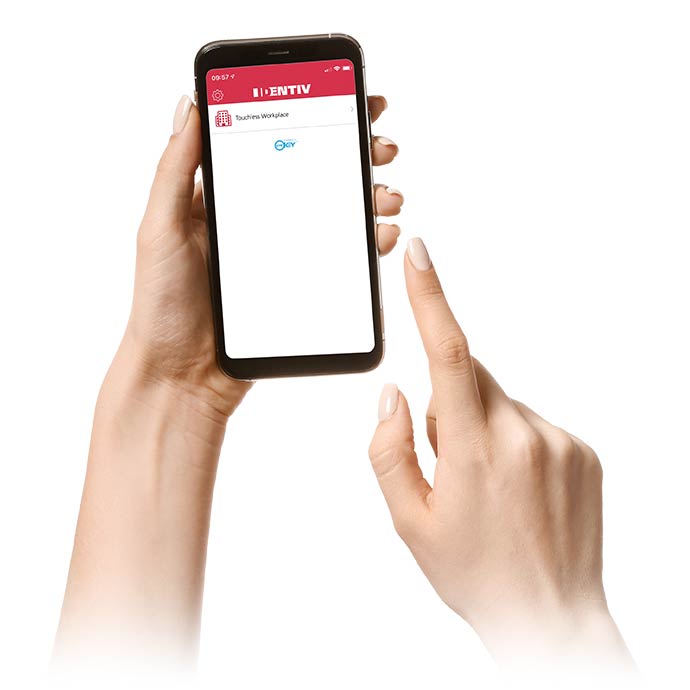Security Sales & Integration: COVID-19 Put These Access Control Solutions in the Spotlight
February 14, 2022

The
original article was published by Steve Karantzoulidis via
Security Sales & Integration.
Experts share how to utilize touchless and biometric solutions, as well as emerging solutions such as contact tracing.
The access control market has come a long way over the past several decades. Homeowners have gone from requiring a key to open their doors to being able to simply wave their cellphone (which themselves have evolved from chunky pieces of plastic to slick mini computers.)
Instead of having to remember to carry around a keycard to swipe into their office, employees can authenticate their identities using the latest biometric technology.
Access control is following the modern technology trends of ease-of-use and convenience, which in this market’s case generally means the use of touchless technology. Touchless solutions can create less friction, literally. Users don’t have to worry about remembering their physical credential or having to come in contact with a “high touchpoint” during this time of increased hygiene concern.
On that note, the
COVID-19 pandemic severely altered the access control market and, in many ways, accelerated its evolution. Ahead, we’ll look at the pandemic’s impact on this market, what solutions have benefited from it and how integrators can take advantage.
Pandemic Shifts Focus
It’s crazy to think that it has been nearly two full years since COVID-19 began to consume North America along with the rest of the world. While many were expecting, or at least hoping, to get back to some semblance of normalcy by now, the Omicron variant has made the first couple months of 2022 look a lot like those of 2020.
It was then that brick-and-mortar businesses started going into hibernation and employees began migrating to a work-from-home situation.
Though the pandemic initially created a slowdown in security and integration projects due to buildings being closed, the industry quickly saw a demand for solutions that would get people out of their homes and back into offices, stores, restaurants and more.
According to Despina Stamatelos, Genetec’s commercial senior manager for access control, the pandemic transformed the needs of end users as they grappled with new sanitary measures and regulations and led to an interest in new access control solutions.
“This includes being able to manage occupancy rates and track contagion in the case where an infected individual came in proximity with others. Additionally, end users are looking for new ways to manage access with minimal friction. And so, we saw an uptake in frictionless biometrics as well as mobile credentials.”
Businesses were hit hard by the pandemic. Not only did they see a decline in customers, but they also had to deal with constantly changing regulations and protocols. Jeremy Allison, senior product manager for Paxton, says the pandemic has put employee and visitor safety on the radar for all companies.
“We’ve seen a lot of demand from customers to transition to touchless credentials and for remote access. Companies now want to be ready if guidelines or policies need to change at any time and the systems they use need to have the features to provide them with that flexibility.”
The Rapid Rise of Touchless
The industry had been seeing an increased demand for mobile credentials and the pandemic has only accelerated their adoption. By utilizing a smartphone as a credential, the user doesn’t need to worry about coming into contact with a high-touchpoint surface. Identiv GM of Premises Mark Allen adds that another benefit is Bluetooth-based mobile credentials can be more secure than a keycard.
Biometric methods, such as, hand waving, iris scan and facial recognition readers, are poised for increased adoption. In fact, OMDIA says facial recognition readers are expected to grow by 27% CAGR by 2025.
Biometric access control solutions are quick, accurate and frictionless.
It is important for integrators to gain an understanding of their customers’ needs and create awareness of the existence of these solutions and their benefits. Let the customer know how these solutions can both solve a current problem and be able to adapt to changes in the near future.
“Just a simple conversation with the customer about company policies and how they have handled the pandemic will help integrators with which system and features need to be sold. For example, if the customer states they are now 50% remote/hybrid working. This easily opens up the conversation for mobile credentials and remote building management,” says Allison.

Mobile credentials provide a touch-free access control experience and can be more secure than traditional keycards.
Utilizing New (and Old) Solutions
Mark Robinton, V.P. IoT services for HID Global, notes that the pandemic has exacerbated some already existing challenges in the access control market and driven companies to adopt new technologies sooner than they may have done without the emergence of the virus.
“For example, organizations have long wanted to know who and when outside visitors have entered and exited their facilities for security purposes, but in the pandemic, it’s become increasingly important to know whom everyone has interacted with in case of a COVID-19 outbreak.”
Two solutions that have gained attention over the past two years are people counting and occupancy monitoring. Though these solutions existed prior to COVID — most commonly for business intelligence — they are now in demand to assist in stopping the spread of the virus. Also gaining more attention and demand is contact tracing. Let’s delve into these solutions.
People Counting/Occupancy Monitoring
When businesses began to reopen following the initial COVID panic, many were forced to observe strict occupancy limits. Though a store could assign an employee to stand by the door with a pen and paper to keep track of how many people have come and gone, it would be more efficient to utilize an automated solution. The right solution can provide peace of mind for both customers and workers alike. It also has numerous benefits in an office setting.
“People counting and occupancy monitoring allows end users to better allocate resources, reduce facility expenses and ensure public health regulations are being followed by being able to manage occupancy, understand employee attendance throughout the facility and manage desk assignments,” says Stamatelos.
These solutions can provide much value to retailers, typically including analytics, reporting tools and alerts for when occupancy limits are being reached. Employees or managers can then receive those alerts on a mobile device, email or in the security platform being utilized.
Contact Tracing
Contact tracing solutions provide the ability to see the occupancy of a specific space and for how long a person was in that space, so if someone was to test positive for COVID-19, everyone that was in the vicinity could easily be notified and take the appropriate measures. There are different ways this can be done.
One of the more unique methods to emerge is the use of Bluetooth Low Energy (BLE) fobs combined with real-time location services. Employees wear a fob that communicates with a gateway that records a full digital trail of an employee’s whereabouts and historical interactions.
“Wearable beacons can provide accurate reports on the duration of employee interaction. Instead of days to gather all the information, contact tracing reports can be run in minutes, so those who may have come in contact with an infected person can be notified as soon as possible,” explains Robinton. “Enhanced systems can even function as reminders to remain the CDC recommended six feet apart by sending a visual or audible cue to the beacon.”
The New Access Control Normal
Though innovative access control solutions have seen a swell of interest due to the pandemic, it does not mean we should expect that attention to subside once things get “back to normal.” Mobile credentials, biometrics, occupancy management — these are all things that can make the average person’s life more convenient and safer.
“The products that have been created are mostly not going to go away and we’re going to learn from this pandemic. Businesses are going to learn from this pandemic. We’ll have better people management systems and processes, better disaster preparedness. Hoteling, work from home, cybersecurity — all of those are going to make us more secure,” says Allen.
Robinton echoes this sentiment, saying that although COVID has exacerbated some already existing challenges in the access control market and driven companies to adopt new technologies sooner than they may have done without the emergence of the virus, those technologies are likely to stick around.
“Organizations want technology that that has a life beyond COVID. They are searching for open platforms that can be used for employee security and safety with additional features like duress alarms, building monitoring features, even the ability to track equipment health in real-time, all while building on their initial investment,” he notes.